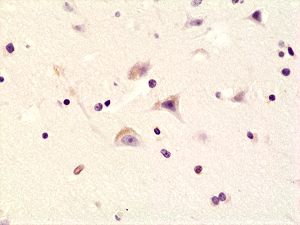anti-Phospho-AMPA Receptor (Ser845) (human) Rabbit Monoclonal (RM296)
| Code | Size | Price |
|---|
| REV-31-1179-00-R100 | 100 ul | £455.00 |
Quantity:
Prices exclude any Taxes / VAT
Overview
Antibody Isotype: Rabbit IgG
Antibody Clonality: Recombinant Antibody
Antibody Clone: RM296
Regulatory Status: RUO
Target Species: Human
Applications:
- Immunohistochemistry (IHC)
- Western Blot (WB)
Shipping:
Blue Ice
Storage:
+4°C
Images
Documents
Further Information
Alternate Names/Synonyms:
Glutamate Receptor 1; GluR 1; GluA1; GluR-A; GluR-K1
Concentration:
N/A
EClass:
32160000
Form (Short):
liquid
Formulation:
Liquid. 50% Glycerol/PBS with 1% BSA and 0.09% sodium azide.
Handling Advice:
Avoid freeze/thaw cycles.
Immunogen:
A phospho-peptide corresponding to human Phospho-Glutamate Receptor 1 (GluR1) (Ser845).
Long Description:
Recombinant Antibody. This antibody reacts to human Glutamate Receptor 1, AMPA Receptor (GluR1) only when phosphorylated at Ser845. There is no cross-reactivity to GluR1 that is not phosphorylated at Ser845. This antibody may also react to mouse or rat Phospho-AMPA Receptor (GluR1) (Ser845) as predicted by immunogen homology. Applications: WB, IHC. Source: Rabbit. Liquid. 50% Glycerol/PBS with 1% BSA and 0.09% sodium azide. AMPA receptors (AMPARs) are heterotetrameric complexes composed of subunits GluR1?4, each of them conferring specific properties on the active receptor, including trafficking motifs, which is related to synaptic plasticity. These glutamate receptors are responsible for the fast, immediate postsynaptic response to glutamate release. Therefore, the receptor?channel complex, predominantly permeable for sodium and potassium ions, activates fast and shows rapid desensitization. AMPA receptors are abundant and widely distributed in the central nervous system. GluR1 (Glutamate Receptor 1) is an ionotropic glutamate receptor. L-glutamate acts as an excitatory neurotransmitter at many synapses in the central nervous system. Binding of the excitatory neurotransmitter, L-glutamate, induces a conformation change that leads to the opening of the cation channel and converts the chemical signal to an electrical impulse. Then, the receptor desensitizes rapidly and enters a transiet inactive state characterized by the presence of a bound agonist. In the presence of CACNG4, CACNG7, or CACNG8, GluR1 shows resensitization which is characterized by a delayed accumulation of current flux upon continued application of glutamate. Phosphorylation of GluR1 is critical for long-term potentiation (LTP) and long-term depression (LTD) expression and the retention of memories.
NCBI, Uniprot Number:
P42261
Package Type:
Vial
Product Description:
AMPA receptors (AMPARs) are heterotetrameric complexes composed of subunits GluR1?4, each of them conferring specific properties on the active receptor, including trafficking motifs, which is related to synaptic plasticity. These glutamate receptors are responsible for the fast, immediate postsynaptic response to glutamate release. Therefore, the receptor?channel complex, predominantly permeable for sodium and potassium ions, activates fast and shows rapid desensitization. AMPA receptors are abundant and widely distributed in the central nervous system. GluR1 (Glutamate Receptor 1) is an ionotropic glutamate receptor. L-glutamate acts as an excitatory neurotransmitter at many synapses in the central nervous system. Binding of the excitatory neurotransmitter, L-glutamate, induces a conformation change that leads to the opening of the cation channel and converts the chemical signal to an electrical impulse. Then, the receptor desensitizes rapidly and enters a transiet inactive state characterized by the presence of a bound agonist. In the presence of CACNG4, CACNG7, or CACNG8, GluR1 shows resensitization which is characterized by a delayed accumulation of current flux upon continued application of glutamate. Phosphorylation of GluR1 is critical for long-term potentiation (LTP) and long-term depression (LTD) expression and the retention of memories.
Purity:
Protein A purified.
Source / Host:
Rabbit
Specificity:
This antibody reacts to human Glutamate Receptor 1, AMPA Receptor (GluR1) only when phosphorylated at Ser845. There is no cross-reactivity to GluR1 that is not phosphorylated at Ser845. This antibody may also react to mouse or rat Phospho-AMPA Receptor (GluR1) (Ser845) as predicted by immunogen homology.
Transportation:
Non-hazardous
UNSPSC Category:
Primary Antibodies
UNSPSC Number:
12352203
Use & Stability:
Stable for at least 1 year after receipt when stored at -20°C.



